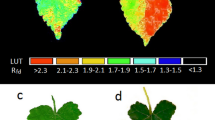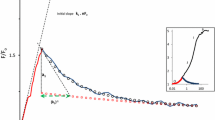Abstract
The photosynthetic apparatus of higher plants acclimates to irradiance. Among the features which are changing is the pool size of the pigments belonging to the violaxanthin cycle, in which zeaxanthin is formed. In high light grown leaves, the violaxanthin cycle pool size is up to five times larger than in low light. The changes are reversible on a time scale of several days. Since it has been published that violaxanthin cycle pigments do not transfer absorbed energy to chlorophyll, we hypothesized that excitation of chlorophyll fluorescence in the blue spectral region may be reduced in high light-acclimated leaves. Fluorescence excitation spectra of leaves of the Arabidopsis thaliana tt3 mutant showed strong differences between high and low light-acclimated plants from 430 to 520 nm. The resulting difference spectrum was similar to carotenoids but shifted by about 20 nm to higher wavelengths. A good correlation was observed between the fluorescence excitation ratio F 470/F 660 and the violaxanthin cycle pool size when leaves were acclimated to a range of irradiances. In parallel to the decline of F 470/F 660 with high light acclimation also the quantum yield of photosynthetic oxygen evolution in blue light decreased. The data confirm that violaxanthin cycle carotenoids do not transfer absorbed light to chlorophyll. It is proposed to use the ratio F 470/F 660 as an indicator for the light acclimation status of the chloroplasts in a leaf.







Similar content being viewed by others
References
Adams WW, Demmig-Adams B (1992) Operation of the xanthophyll cycle in higher plants in response to diurnal changes in incident light. Planta 186:390–398
Agati G, Stefano G, Biricolti S, Tattini M (2009) Mesophyll distribution of ‘antioxidant’ flavonoid glycosides in Ligustrum vulgare leaves under contrasting sunlight irradiance. Ann Bot 104:853–861
Bilger W, Björkman O, Thayer SS (1989) Light-induced spectral absorbance changes in relation to photosynthesis and the epoxidation state of xanthophyll cycle components in cotton leaves. Plant Physiol 91:542–551
Bilger W, Fisahn J, Brummet W, Kossmann J, Willmitzer L (1995) Violaxanthin cycle pigment contents in potato and tobacco plants with genetically reduced photosynthetic capacity. Plant Physiol 108:1479–1486
Bilger W, Veit M, Schreiber L, Schreiber U (1997) Measurement of leaf epidermal transmittance of UV radiation by chlorophyll fluorescence. Physiol Plant 101:754–763
Bilger W, Rolland M, Nybakken L (2007) UV screening in higher plants induced by low temperature in the absence of UV-B radiation. Photochem Photobiol Sci 6:190–195
Björkman O, Demmig-Adams B (1994) Regulation of photosynthetic light energy capture, conversion, and dissipation in leaves of higher plants. In: Schulze E-D, Caldwell MM (eds) Ecophysiology of photosynthesis, ecological studies, vol 100. Springer, Berlin, pp 17–70
Caffari S, Croce R, Breton J, Bassi R (2001) The major antenna complex of photosystem II has a xanthophyll binding site not involved in light harvesting. J Biol Chem 276:35924–35933
Caffari S, Tibiletti T, Jennings RC, Santabarbara S (2014) A comparison between plant photosystem I and photosystem II architecture and functioning. Curr Protein Pept Sci 15:296–331
Cerovic ZG, Ounis A, Cartelat A, Latouche G, Goulas Y, Meyer S, Moya I (2002) The use of chlorophyll fluorescence excitation spectra for the non-destructive in situ assessment of UV-absorbing compounds in leaves. Plant Cell Environ 25:1663–1676
Croce R, Weiss S, Bassi R (1999) Carotenoid-binding sites of the major light-harvesting complex II of higher plants. J Biol Chem 274:29613–29623
Davies BH (1976) Carotenoids. In: Goodwin TW (ed) Chemistry and biochemistry of plant pigments. Academic Press, London, pp 38–165
De Weerd FL, Dekker JP, van Grondelle P (2003) Dynamics of β-carotene-to-chlorophyll singlet energy transfer in the core of photosystem II. J Phys Chem B 107:6214–6220
Demmig B, Winter K, Krüger A, Czygan F-C (1987) Photoinhibition and zeaxanthin formation in intact leaves. Plant Physiol 84:218–224
Demmig-Adams B, Adams WW (1992) Photoprotection and other responses of plants to high light stress. Annu Rev Plant Phys 43:599–626
Demmig-Adams B, Adams WW, Hebr U, Neimanis S, Winter K, Krüger A, Czygan F-C, Bilger W, Björkman O (1990) Inhibition of zeaxanthin formation and of rapid changes in radiationless energy dissipation by dithiothreitol in spinach leaves and chloroplasts. Plant Physiol 92:293–301
Demmig-Adams B, Garab G, Adams W, Govindjee (2014) Non-photochemical quenching and energy dissipation in plants, algae and cyanobacteria. Springer, Dordrecht
Gamon JA, Berry JA (2012) Facultative and constitutive pigment effects on the photochemical reflectance index (PRI) in sun and shade conifer needles. Isr J Plant Sci 60:85–95
Gamon JA, Field CB, Bilger W, Björkman O, Fredeen AL, Peñuelas J (1990) Remote sensing of the xanthophyll cycle and chlorophyll fluorescence in sun flower leaves and canopies. Oecologia 85:1–7
Gamon JA, Peñuelas J, Field CB (1992) A narrow-waveband spectral index that tracks diurnal changes in photosynthetic efficiency. Remote Sens Environ 41:35–44
Garbulsky MF, Penuelas J, Gamon JA, Inoue Y, Filella I (2011) The photochemical reflectance index (PRI) and the remote sensing of leaf, canopy and ecosystem radiation use efficiencies. A review and meta-analysis. Remote Sens Environ 115:281–297
Havaux M, Niyogi KK (1999) The violaxanthin cycle protects plants from photooxidative damage by more than one mechanism. Proc Natl Acad Sci USA 96:8762–8767
Havaux M, Dall’Osto L, Bassi R (2007) Zeaxanthin has enhanced antioxidant capacity with respect to all other xanthophylls in Arabidopsis leaves and functions independent of binding to PSII antennae. Plant Physiol 145:1506–1520
Haxo FT (1960) The wavelength dependence of photosynthesis and the role of accessory pigments. In: Allen MB (ed) Comparative Biochemistry of Photoreactive Systems. Symposia on comparative biology of the Kaiser Foundation Research Institute, vol 1. Academic Press, New York, pp 339–360
Hogewoning SW, Wientjes E, Douwstra P, Trouwborst G, van Ieperen W, Croce R, Harbinson J (2012) Photosynthetic quantum yield dynamics: from photosystems to leaves. Plant Cell 24:1921–1935
Huner NPA, Maxwell DP, Gray GR, Savitch LV, Krol M, Ivanov AG, Falk S (1996) Sensing environmental temperature change through imbalances between energy supply and energy consumption: redox state of photosystem II. Physiol Plant 98:358–364
Inada K (1976) Action spectra for photosynthesis in higher plants. Plant Cell Physiol 17:355–365
Jahns P, Holzwarth AR (2012) The role of the xanthophyll cycle and of lutein in photoprotection of photosystem II. Biochim Biophys Acta 1872:182–193
Kirakosyan A, Kaufman P, Warber S, Zick S, Aaronson K, Bolling S, Chang SC (2004) Applied environmental stresses to enhance the levels of polyphenolics in leaves of hawthorn plants. Physiol Plant 121:182–186
Li J, Ou-Lee T-M, Raba R, Amundson R, Last RL (1993) Arabidopsis flavonoid mutants are hypersensitive to UV-B irradiation. Plant Cell 5:171–179
Lichtenthaler H, Pfister K (1978) Praktikum der Photosynthese. Quelle & Meyer, Heidelberg
Liu Z, Yan H, Wang K, Kuang T, Zhang J, Gui L, An X, Chang W (2004) Crystal structure of spinach major light harvesting complex at 2.72 Å resolution. Nature 428:287–292
Logan BA, Barker DH, Demmig-Adams B, Adams WW (1996) Acclimation of leaf carotenoid composition and ascorbate levels to gradients in the light environment within an Australian rainforest. Plant Cell Environ 19:1083–1090
Løvdal T, Olsen KM, Slimestad R, Verheul M, Lillo C (2010) Synergetic effects of nitrogen depletion, temperature, and light on the content of phenolic compounds and gene expression in leaves of tomato. Phytochemistry 71:605–613
Markstädter C, Queck I, Baumeister J, Riederer M, Schreiber U, Bilger W (2001) Epidermal transmittance of leaves of Vicia faba for UV radiation as determined by two different methods. Photosynth Res 67:17–25
Martiskainen J, Kananavičius R, Linnanto J, Lehtivuori H, Keränen M, Aumanen V, Tkachenko N, Korppi-Tommola J (2011) Excitation energy transfer in the LHC-II trimer: from carotenoids to chlorophylls in space and time. Photosynth Res 107:195–207
McCree KJ (1972a) The action spectrum, absorptance and quantum yield of photosynthesis in crop plants. Agric Meteorol 9:191–216
McCree KJ (1972b) Test of current definitions of photosynthetically active radiation against leaf photosynthesis data. Agric Meteorol 10:443–453
Niinemets Ü, Kollist H, Garcia-Plazaola JI, Hernandez A, Becerill JM (2003) Do the capacity and kinetics for modification of xanthophyll cycle pool size depend on growth irradiance in temperate trees? Plant Cell Environ 26:1787–1801
Niyogi KK (1999) Photoprotection revisited: genetic and molecular approaches. Annu Rev Plant Phys Plant Mol Biol 50:333–359
Niyogi KK, Bjorkman O, Grossman AR (1997) Chlamydomonas xanthophyll cycle mutants identified by video imaging of chlorophyll fluorescence quenching. Plant Cell 9:1369–1380
Olsen KM, Slimestad R, Lea US, Brede C, Løvdal T, Ruoff P, Verheul M, Lillo C (2009) Temperature and nitrogen effects on regulators and products of the flavonoid pathway: experimental and kinetic model studies. Plant Cell Environ 32:286–299
Pfündel E (1998) Estimating the contribution of photosystem I to total leaf chlorophyll fluorescence. Photosynth Res 56:185–195
Porra RJ, Thompson WA, Kriedemann PE (1989) Determination of accurate extinction coefficients and simultaneous equations for assaying chlorophylls a and b extracted with four different solvents: verification of the concentration of chlorophyll standards by atomic absorption spectroscopy. Biochim Biophys Acta 975:384–394
Sheahan JJ (1996) Sinapate esters provide greater UV-B attenuation than flavonoids in Arabidopsis thaliana (Brassicaceae). Am J Bot 83:679–686
Siefermann-Harms D (1987) The light-harvesting and protective functions of carotenoids in photosynthetic membranes. Physiol Plant 69:561–568
Sims DA, Gamon JA (2002) Relationships between leaf pigment content and spectral reflectance across a wide range of species, leaf structures and developmental stages. Rem Sens Environ 81:337–354
Terashima I, Fujita T, Inoue T, Chow WS, Oguchi R (2009) Green light drives leaf photosynthesis more efficiently than red light in strong white light: revisiting the enigmatic question of why leaves are green. Plant Cell Physiol 50:684–697
Thayer SS, Björkman O (1990) Leaf xanthophyll content and composition in sun and shade determined by HPLC. Photosynth Res 23:331–343
Wong CYS, Gamon JA (2015a) Three causes of variation in the photochemical reflectance index (PRI) in evergreen conifers. New Phytol 206:187–195
Wong CYS, Gamon JA (2015b) The photochemical reflectance index provides an optical indicator of spring photosynthetic activation in evergreen conifers. New Phytol 206:196–208
Yamamoto HY, Wang YY, Kamite L (1972) An ascorbate-induced absorbance change in chloroplasts from violaxanthin de-epoxidation. Plant Physiol 49:224–228
Acknowledgments
Funding by the German Federal Ministry of Education and Research as part of the WeGa research network (Project-No: 0315542B) is gratefully acknowledged. We thank Andrea Behrens, Kathrin Fischer, Lili Beckmann and Christian Pawlitzki for the measurements with the field grown plants.
Author information
Authors and Affiliations
Corresponding author
Electronic supplementary material
Below is the link to the electronic supplementary material.
Rights and permissions
About this article
Cite this article
Nichelmann, L., Schulze, M., Herppich, W.B. et al. A simple indicator for non-destructive estimation of the violaxanthin cycle pigment content in leaves. Photosynth Res 128, 183–193 (2016). https://doi.org/10.1007/s11120-016-0218-1
Received:
Accepted:
Published:
Issue Date:
DOI: https://doi.org/10.1007/s11120-016-0218-1




